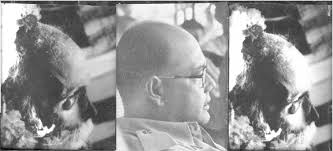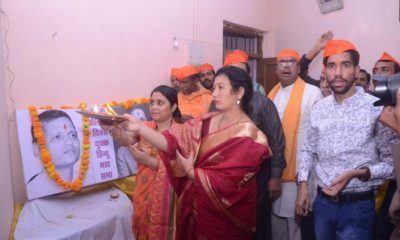Feature
Netaji cremated in Taikhou, claims British website
 London:Netaji Subhas Chandra Bose was cremated in Taihoku, Japanese name for Taipei, as the coffin was too long to be put in plane bound for Tokyo, where the body was originally scheduled to be taken for performing his last rites, a British website claimed quoting a Taiwanese official present at the cremation.
London:Netaji Subhas Chandra Bose was cremated in Taihoku, Japanese name for Taipei, as the coffin was too long to be put in plane bound for Tokyo, where the body was originally scheduled to be taken for performing his last rites, a British website claimed quoting a Taiwanese official present at the cremation.
The website, www.bosefiles.info has been coming out with serialised ‘revelations” backing the theory that the Indian revolutionary leader died in a plane cash on August 18, 1945, in Taiwan.
In its latest post on Thursday, the site created by London-based journalist and Netaji’s grand nephew Ashish Roy referred to the evidence provided by Tan Ti-Ti, who was in charge of issuing cremation permits in Taipei, together with that of other local officials, to buttress its claim.
Tan Ti-Ti, in his testimony contained in the British Foreign Office’s file number FC1852/6 of 1956, said that he personally attended to Bose’s body at the concerned crematorium.
It also transpires from the file that Japanese army officers probably did not issue a death certificate in Bose’s name to maintain secrecy about his demise.
Ko Keng Yuan, who was the Director of the Health Centre in Taipei, stated the matter of Bose’s death and whether the cremation permit was issued under an assumed name “were important secrets of the Japanese military”.
Eleven years after the alleged air crash, British Consul General in Taiwan Albert Franklin wrote to the Taiwanese government requesting an investigation into the death of Bose.
In response, C.K. Yen, Chairman of the Taiwan Provincial Government, sent a detailed police report dated June 27, 1956. This included an interview with Tan Ti-Ti, who said the cremation took place on August 22, 1945.
A Japanese army officer who accompanied the body told Tan Ti-Ti: “The deceased was Bose, the Indian leader who, proceeding to Tokyo on important business, was injured when his plane was involved in an accident.”
The previous day – August 21, 1945 – the same Japanese officer, according to Tan Ti-Ti, “submitted the death certificate of a certain Ichiro Okura”.
Yen clarified to Franklin that during World War 2 in the case of military personnel A- Bose was then Supreme Commander of the Indian National Army – without family members in Taiwan, “permission for cremation was granted on the strength of a certificate from a military hospital”.
This appears to have occurred in the case of Bose, the website claimed.
The police findings based on a report prepared by Taiwan’s Department of Health said: “There is a register of cremations at the Municipal Health Centre and the officers of the Health Centre are of the opinion that the entry was made in the name of Ichiro Okura.”
Tan Ti-Ti confirmed that on the day of the cremation, the same Japanese army officer “came to the crematorium in a car in the company of an Indian”, said to be Bose’s aide-de-camp Colonel Habibur Rehman, who survived the crash.
He went on to say “the Indian, it was said he was Bose’s follower, some said he was an aide-de-camp; he was dressed in the white garment of Japanese soldiers under medical care, wore slippers, parts of his face were bandaged; he was tall and swarthy, wept bitterly and seemed extremely sorrowful”.
Tan Ti-Ti asserted he and another person called Lin Sui Mu opened the coffin. He added the body had been “put into a coffin for conveyance to Tokyo but the coffin was too big for aeroplanes available at the timea. It was, therefore, cremated in Taipei.
The next day (August 23, 1945), the Indian (Col. Rehman) and the same Japanese army officer came to collect the ashes, Tan Ti-Ti further maintained.
Tan Ti-Ti’s testimony matches that of Colonel Habibur Rehman.
“I requested the (Japanese) Army authorities to arrange for the early transportation of the body either to Singapore or Tokyo, preferably to Singapore,” Rehman testified on August 24, 1945.
He went on: “On 21-8-45 a senior Japanese Staff Officer informed me in the hospital that the length of box (coffin) did not allow the box being put into the plane. He suggested that the body be cremated in Taihoku.
“Seeing no other alternative, I agreed to the suggestion and the body was cremated on 22-8-1945 at Taihoku under the arrangement of the Army authorities. The ashes were collected on 23-8-1945.”
Entertainment
Meghalaya Reserves Legalized Gambling and Sports Betting for Tourists

The State Scores Extra High on Gaming-Friendly Industry Index
Meghalaya scored 92.85 out of 100 possible points in a Gaming Industry Index and proved to be India’s most gaming-friendly state following its recent profound legislation changes over the field allowing land-based and online gaming, including games of chance, under a licensing regime.
The index by the UK India Business Council (UKIBC) uses a scale of 0 to 100 to measure the level of legalisation on gambling and betting achieved by a state based on the scores over a set of seven different games – lottery, horse racing, betting on sports, poker, rummy, casino and fantasy sports
Starting from February last year, Meghalaya became the third state in India’s northeast to legalise gambling and betting after Sikkim and Nagaland. After consultations with the UKIBC, the state proceeded with the adoption of the Meghalaya Regulation of Gaming Act, 2021 and the nullification of the Meghalaya Prevention of Gambling Act, 1970. Subsequently in December, the Meghalaya Regulation of Gaming Rules, 2021 were notified and came into force.
All for the Tourists
The move to legalise and license various forms of offline and online betting and gambling in Meghalaya is aimed at boosting tourism and creating jobs, and altogether raising taxation revenues for the northeastern state. At the same time, the opportunities to bet and gamble legally will be reserved only for tourists and visitors.
“We came out with a Gaming Act and subsequently framed the Regulation of Gaming Rules, 2021. The government will accordingly issue licenses to operate games of skill and chance, both online and offline,” said James P. K. Sangma, Meghalaya State Law and Taxation Minister speaking in the capital city of Shillong. “But the legalized gambling and gaming will only be for tourists and not residents of Meghalaya,” he continued.
To be allowed to play, tourists and people visiting the state for work or business purposes will have to prove their non-resident status by presenting appropriate documents, in a process similar to a bank KYC (Know Your Customer) procedure.
Meghalaya Reaches Out to a Vast Market
With 140 millions of people in India estimated to bet regularly on sports, and a total of 370 million desi bettors around prominent sporting events, as per data from one of the latest reports by Esse N Videri, Meghalaya is set to reach out and take a piece of a vast market.
Estimates on the financial value of India’s sports betting market, combined across all types of offline channels and online sports and cricket predictions and betting platforms, speak about amounts between $130 and $150 billion (roughly between ₹9.7 and ₹11.5 lakh crore).
Andhra Pradesh, Telangana and Delhi are shown to deliver the highest number of bettors and Meghalaya can count on substantial tourists flow from their betting circles. The sports betting communities of Karnataka, Maharashtra, Uttar Pradesh and Haryana are also not to be underestimated.
Among the sports, cricket is most popular, registering 68 percent of the total bet count analyzed by Esse N Videri. Football takes second position with 11 percent of the bets, followed by betting on FIFA at 7 percent and on eCricket at 5 percent. The last position in the Top 5 of popular sports for betting in India is taken by tennis with 3 percent of the bet count.
Local Citizens will Still have Their Teer Betting
Meghalaya residents will still be permitted to participate in teer betting over arrow-shooting results. Teer is a traditional method of gambling, somewhat similar to a lottery draw, and held under the rules of the Meghalaya Regulation of the Game of Arrow Shooting and the Sale of Teer Tickets Act, 2018.
Teer includes bettors wagering on the number of arrows that reach the target which is placed about 50 meters away from a team of 20 archers positioned in a semicircle.
The archers shoot volleys of arrows at the target for ten minutes, and players place their bets choosing a number between 0 and 99 trying to guess the last two digits of the number of arrows that successfully pierce the target.
If, for example, the number of hits is 256, anyone who has bet on 56 wins an amount eight times bigger than their wager.
















